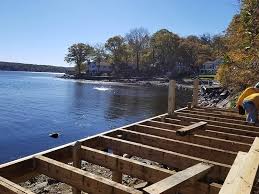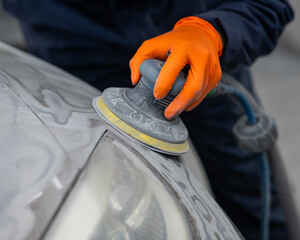Wood naturally rots and degrades over time. Dock Repair involves a thorough inspection of wooden dock posts and planks. This includes going underwater with scuba or snorkel gear to inspect the integrity of the dock.

Unsafe docks can lead to serious injuries and property damage. Proactive maintenance and timely repairs will save you money and prolong the life of your floating dock. Learn More Here by reading the article below.
Floats are the foundation of floating docks, and they help to keep the structure stable and buoyant. However, if damaged or worn down, they can significantly reduce the structural integrity of your dock. A sagging or unstable dock is a safety hazard, and it can also detract from the overall aesthetic of your waterfront property. Fortunately, repairing and patching dock floats is a simple process that can save you money and ensure that your dock is safe to use for years to come.
As with any other type of boat or marine vessel, floats experience some wear and tear over time from exposure to saltwater and harsh environmental conditions. It’s essential to inspect and repair your dock floats regularly for damage, debris buildup, and algae growth.
To repair a ding in a dock float, first clean the surface with mild soap and water to remove any dirt or debris. Then, sand the area lightly with fine-grit sandpaper to smooth it out and prevent any further damage from occurring. It is also important to use a waterproof sealant such as Belzona 2211 to ensure that the ding will not leak.
Most dings and scratches on a dock float can be easily repaired by using a touch-up paint or stain. However, a severe dent may be unrepairable.
Inspect the floats for visible damage, such as cracks or drain holes. You should also check for a low freeboard, which can indicate compromised buoyancy. If you notice any of these issues, it is crucial to take immediate action to avoid water intrusion and structural damage.
The most common causes of damage to a dock float are corrosion, punctures, or physical damage. Corrosion is typically the result of prolonged exposure to saltwater. It can accelerate the deterioration of the float, so it’s important to protect them with protective coatings and apply regular maintenance. Moreover, punctures can be caused by objects such as anchor chains, fishing lines, or other gear.
Warped Boards
Wood warping is a common problem that can be caused by a variety of factors. However, the two most significant causes are moisture and temperature. When a piece of wood is exposed to excess water or extreme heat, the cells within the fibers expand and contract at different rates, which leads to the warping of the board. This can be prevented by ensuring that your boards are properly stored and covered.
When storing your wood boards, make sure that they are laid flat and on an elevated surface if possible. This will help to prevent any potential moisture damage and also give the fibers in the wood a chance to stabilize themselves. It’s also important to cover your boards with a waterproof coating or sealant, which will further protect the fibers from moisture and help them stay in good shape.
Once a piece of wood is warped, it can be difficult to get it back into a usable state. Depending on the severity of the issue, it may be easier to use a shorter piece of wood instead of trying to fix the entire length of the board. However, if you are determined to use the board, there are some ways to fix it.
One way to get rid of a warp is to apply pressure. To do this, first soak a towel in water and then wrap it around the warped board. Next, place the wrapped board on a solid surface and expose it to sunlight. Over time, the heat from the sun will gradually straighten out the board.
Another way to get rid of a warp involves using a jack plane. This is a tool that requires some experience and knowledge to use safely, but it can be effective in getting rid of a warp. First, look at your warped board and identify the side that has a C or cup shape. Then, use the jack plane to remove some of the wood from the top of the board, which will help it to straighten out.
You can also try applying a heating device to your wood, such as an iron or a hair dryer. This will also help to straighten out the boards and can be especially useful if your board is experiencing bowing.
Corrosion
Over time, metal components of a dock can start to show signs of corrosion. This may occur due to abrasion or exposure to salt water. Corrosion can weaken the structural integrity of a dock, making it more vulnerable to damage from waves and marine life. When a dock experiences corrosion, it is important to get it repaired right away.
A professional repair crew will first examine the dock for any problems that need to be addressed. This includes examining the decking, floats and supporting pilings and piers for signs of rot or corrosion. It is also important to check for any areas where the decking or planks are splintering, which can cause safety hazards. The professionals will also inspect the floats for cracks or any other issues that could make them unreliable.
If the floats have been damaged, the professionals will begin to replace them. Before doing so, they will make sure the floats are detached from the dock in a safe manner. This will often involve chipping away at rusted bolts or untying knots that hold the floats together. Once the floats are replaced, the crew will apply a waterproof sealant to help protect the new floats from further damage.
When it comes to repairing a dock, the most important thing is that the professionals do it in a safe and secure environment. This includes wearing protective gear and ensuring that no one is around while the work is being done. The crew should also prepare any tools or materials they need before beginning the repair process. For example, they should have threaded plastic plugs ready to cover any old vent holes in the floats.
Performing regular maintenance on a dock can reduce the need for repairs, but even with proper care, all docks will need replacement eventually. Knowing when to choose repair over replacement can save money and prevent serious injuries. Learn how to recognize the difference between a repairable and a replacement dock, so you can keep your waterfront home safe and functional for years to come.
Wood Rot
Wood rot is a serious and often dangerous issue that can damage the integrity of structures such as decks, docks and homes. It’s caused by fungus and can lead to significant structural damage and pose health problems such as mold inhalation. Fortunately, both wet and dry rot can usually be repaired with preservative treatments. However, the extent of treatment will depend on the extent of the damage and the type of fungus present.
Wet rot is typically less severe than dry rot and can usually be treated by removing the affected boards and treating new boards with a preservative that kills the fungus. Dry rot is harder to treat and requires a more extensive process. First, the spores of the fungus must be killed. This is accomplished by applying a solution such as boric acid to the damaged timbers. This is then covered with a special mixture that stops the fungus from spreading. Once the fungus has been killed and the timbers are thoroughly dried, a wood filler can then be used to repair any holes or cracks.
Depending on the type of fungus, if the damage to wood is severe, it may be necessary to replace it entirely. This is a complex and time-consuming task that should be left to professionals. However, replacing damaged wood is a good way to upgrade the appearance of a structure, as well as to add some decorative elements to a home.
Fungus attacks the cellulose, hemicellulose and lignin in wood which is why it’s essential to keep wooden materials as dry as possible. In addition, fungus grows much faster in moist conditions. That’s why it’s important to have regular inspections of your property and catch plumbing leaks and roof leaks as soon as they occur.
The most effective way to avoid wood rot is to use the best quality wooden materials that you can afford, especially in areas exposed to the elements. It’s also a good idea to choose pretreated wood, as this will be more resistant to the growth of fungus than untreated wood.

